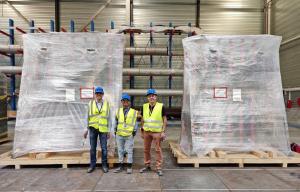Electron cyclotron system
First power supply delivered
16 Dec 2019
-
Mark Henderson, Electron Cyclotron Secion Leader
Turning the key in your car causes an electrical current to be sent from your battery to your car's engine, where a small electrode (or "spark plug") generates an electrical discharge to ignite the fuel and make your engine "go." ITER has an equivalent—except the spark to make the plasma "go" is created by sending high-power microwaves (equivalent to 6,000 kitchen microwave ovens) into the vacuum vessel. All of this power creates the initial flash—like the spark plug in your car engine—that initiates each plasma pulse.
F. Albajar, F4E Technical Responsible Officer; Darshan Parmar, ITER Organization Technical Responsible Officer; and Paco Sanchez Arcos, F4E Project Manager, supervising the delivery of Europe's first high voltage power supply set for ITER's electron cyclotron system.
As you can guess, starting the plasma in ITER is more complex than starting your car, which requires only a battery, cables, a spark plug and a switch. ITER's "battery" is a combination of several high voltage power supplies (up to 55 kV) and a host of gyrotrons (ITER's equivalent of the microwave oven). The electron cyclotron system transmits the microwaves to the vacuum chamber using circular waveguides (50 mm pipes) followed by a series of mirrors that focus the microwaves to the centre of the vacuum chamber to create the initial "spark."
Over the past two years, the ITER partners have made significant progress toward supplying the components needed to make ITER First Plasma. Most noticeable is the progress in manufacturing the first set of high voltage power supplies and all eight of the powerful 1 MW microwave sources (gyrotrons) used for First Plasma. Now we are one step closer, with the delivery of the first set of high voltage power supplies.
There will be a total of five power supply sets used for First Plasma coming from Europe, India and Japan, with this first set delivered by the European Domestic Agency (F4E) and its supplier Ampegon (Switzerland). The power supplies are large—a single set weighs approximately 40 tonnes and requires about 250 cubic metres on two floors of the ITER Radio Frequency Building. Although massive, these power supplies represent the state of the art in high voltage power supplies, with the ability to regulate the output voltage in small steps within less than a microsecond.
The high voltage power supply units delivered by Europe (pictured), India and Japan will be installed in the Radio Frequency Building on site. High-power microwaves generated by the power supplies and the gyrotrons will reach the ITER Tokamak by travelling along waveguides.
This is achieved by placing nearly 100 smaller power supplies in series, and switching on and off each supply to provide a controlled ramp-up of the voltage from 0 to 55 kV in roughly 100 milliseconds, then maintain a stable voltage for up to one hour. More rapid control is possible: for example, the power supplies can drop to 0 V in 10 microseconds in the event of a fault in either the gyrotron or downstream toward the machine. These smaller power supplies are made from solid-state transistors that operate with greater than 97% electrical efficiency, with the aim being to maximize the power given to the plasma.
Upon arrival in October, this first power supply set was put in storage—but they will remain there for only a short time until the Radio Frequency Building is finalized on site. This coming summer, Ampegon and European Domestic Agency experts will arrive to install the power supplies. First commissioning will occur in early 2021; then the power supply will be used to power the first set of gyrotrons by the end of 2021. All of the First Plasma power supplies and gyrotrons should be installed and commissioned by mid-2024, in time to perform integrated commissioning and prepare for the first "spark" in 2025.
Read a report on the first-delivered power supply set from the European Domestic Agency here.



